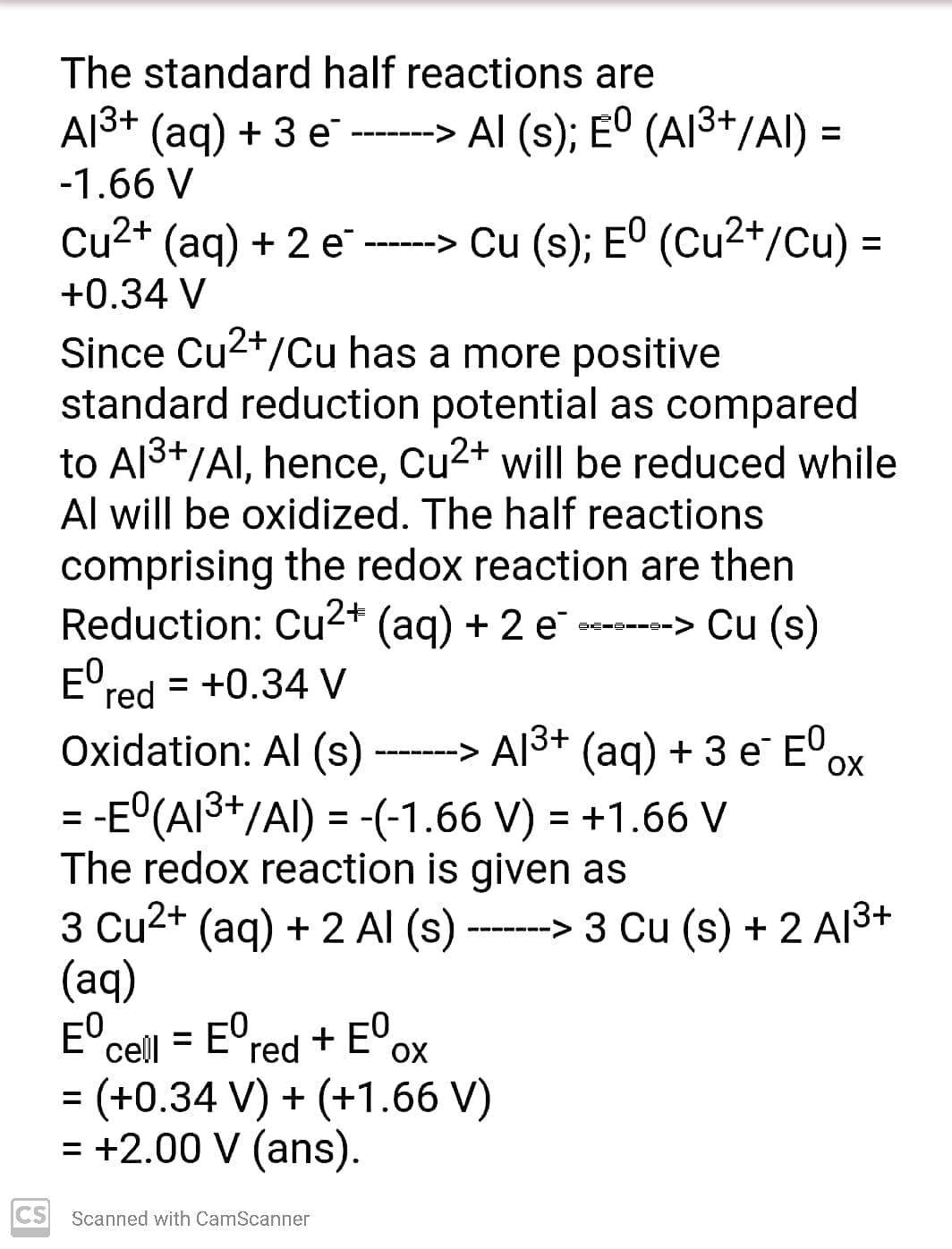Chemistry
10th Edition
ISBN:9781305957404
Author:Steven S. Zumdahl, Susan A. Zumdahl, Donald J. DeCoste
Publisher:Steven S. Zumdahl, Susan A. Zumdahl, Donald J. DeCoste
Chapter1: Chemical Foundations
Section: Chapter Questions
Problem 1RQ: Define and explain the differences between the following terms. a. law and theory b. theory and...
Related questions
Question
Question 5, Part d:
How much energy (in kJ) can be derived
from the oxidation of 6.75 g of aluminum at an average cell potential of 2.00 V?
![**5. Consider the following standard reduction (half-cell) potentials:**
\[ \text{Al}^{3+} (\text{aq}) + 3e^- \rightarrow \text{Al} (\text{s}); \quad E^\circ = -1.66 \, \text{V} \]
\[ \text{Cu}^{2+} (\text{aq}) + 2e^- \rightarrow \text{Cu} (\text{s}); \quad E^\circ = +0.34 \, \text{V} \]
(a) Sketch a voltaic cell consisting of the above half-cells using KNO\(_3\) as a salt-bridge. Label the following: (i) the anode and cathode half-cells; (ii) the positive and negative electrodes; (iii) the direction electron flows in the circuit and ions flow in the salt bridge.
(b) Write the net equation for the overall cell reaction and calculate the standard cell potential (E\(_\text{cell}^\circ\)) at 25°C.
(c) Calculate ΔG° for the overall reaction at 25 °C.
(d) How much energy (in kJ) can be derived from the oxidation of 6.75 g of aluminum at an average cell potential of 2.00 V?](/v2/_next/image?url=https%3A%2F%2Fcontent.bartleby.com%2Fqna-images%2Fquestion%2F16f65cf9-d3bb-4ef1-8d11-46be7a9043fa%2F2bbb06af-2ba0-4b37-9685-435aa4473afd%2Fba16uq_processed.png&w=3840&q=75)
Transcribed Image Text:**5. Consider the following standard reduction (half-cell) potentials:**
\[ \text{Al}^{3+} (\text{aq}) + 3e^- \rightarrow \text{Al} (\text{s}); \quad E^\circ = -1.66 \, \text{V} \]
\[ \text{Cu}^{2+} (\text{aq}) + 2e^- \rightarrow \text{Cu} (\text{s}); \quad E^\circ = +0.34 \, \text{V} \]
(a) Sketch a voltaic cell consisting of the above half-cells using KNO\(_3\) as a salt-bridge. Label the following: (i) the anode and cathode half-cells; (ii) the positive and negative electrodes; (iii) the direction electron flows in the circuit and ions flow in the salt bridge.
(b) Write the net equation for the overall cell reaction and calculate the standard cell potential (E\(_\text{cell}^\circ\)) at 25°C.
(c) Calculate ΔG° for the overall reaction at 25 °C.
(d) How much energy (in kJ) can be derived from the oxidation of 6.75 g of aluminum at an average cell potential of 2.00 V?
Expert Solution
Step 1

Step by step
Solved in 2 steps with 1 images

Recommended textbooks for you

Chemistry
Chemistry
ISBN:
9781305957404
Author:
Steven S. Zumdahl, Susan A. Zumdahl, Donald J. DeCoste
Publisher:
Cengage Learning

Chemistry
Chemistry
ISBN:
9781259911156
Author:
Raymond Chang Dr., Jason Overby Professor
Publisher:
McGraw-Hill Education

Principles of Instrumental Analysis
Chemistry
ISBN:
9781305577213
Author:
Douglas A. Skoog, F. James Holler, Stanley R. Crouch
Publisher:
Cengage Learning

Chemistry
Chemistry
ISBN:
9781305957404
Author:
Steven S. Zumdahl, Susan A. Zumdahl, Donald J. DeCoste
Publisher:
Cengage Learning

Chemistry
Chemistry
ISBN:
9781259911156
Author:
Raymond Chang Dr., Jason Overby Professor
Publisher:
McGraw-Hill Education

Principles of Instrumental Analysis
Chemistry
ISBN:
9781305577213
Author:
Douglas A. Skoog, F. James Holler, Stanley R. Crouch
Publisher:
Cengage Learning

Organic Chemistry
Chemistry
ISBN:
9780078021558
Author:
Janice Gorzynski Smith Dr.
Publisher:
McGraw-Hill Education

Chemistry: Principles and Reactions
Chemistry
ISBN:
9781305079373
Author:
William L. Masterton, Cecile N. Hurley
Publisher:
Cengage Learning

Elementary Principles of Chemical Processes, Bind…
Chemistry
ISBN:
9781118431221
Author:
Richard M. Felder, Ronald W. Rousseau, Lisa G. Bullard
Publisher:
WILEY